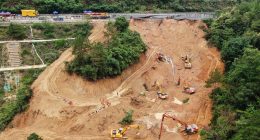
Lyon uses what are known as Border Gateway Protocol routing tables—basically maps of the best and most efficient routes for data to travel across the internet—to generate the Opte visualizations. The data comes from University of Oregon’s RouteViews Archive Project.
As the images came back for IPv6, Lyon says, he was surprised to see the regions of the world that had adopted IPv6 more enthusiastically or more slowly. The tech community in the United States, for example, was slower to incorporate IPv6 than that in the European Union.
Opte also visualizes a leapfrog effect when newer, highly networked technologies like artificial intelligence platforms come online using IPv6 without the legacy infrastructure of digital systems that have been around for decades and slowly revised and improved.
“IPv4 has been around for so long, and it’s fascinating to see technological advances on that network, but IPv6 supports bigger networks by default like AI networks, that are growing at exponential rates where these computers all need to talk to each other,” Lyon says.
Lyon points out that watching IPv4 and the rise and transition to IPv6 through Opte not only illustrates the current moment of the internet, but also begins to shed light on where things may go next.








